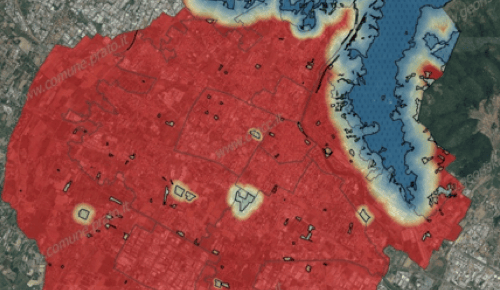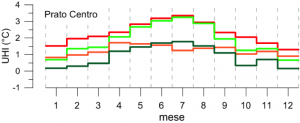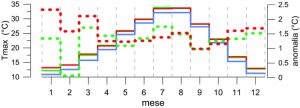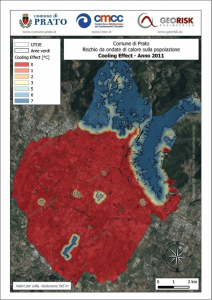
An evaluation of the effects of heat waves on population health between now and 2050 in the municipality of Prato, in Tuscany, with the objective to include it in a municipal strategic plan. It’s the main objective of the research team of Paola Mercogliano, Director of REMHI – Regional Models and geo-Hydrological Impacts Division of the CMCC Foundation, involved in the project ADURB – PRATO.
The main aim of this project is to develop an approach to support policy- and decision-makers in their activities of adaptation planning and implementation by using cutting-edge knowledge in the field of atmospheric sciences and well-established procedures for risk management and evaluation. The first attempt of implementation of this approach has been included in the procedures of the Strategic Environmental Assessment (SEA) of the Operative Plan, a realization of the Structural Plan of the municipality of Prato, in Tuscany. The approach aims in particular at analyzing the current and future impacts of heat waves on population health while taking into consideration climate change induced variations and the planning choices assumed by the Operative Plan.

Figure 1: Difference between the maximum/minimum temperature values recorded in the urban station of Prato Centro and the rural stations (Vaiano: red/green, Artimino:orange/dark green, respectively for maximum and minimum temperature).
Currently, the first two phases of SEA, that is the preliminary phase and the preparation of an Environmental Report, have been completed. As illustrated in these documents, the project ADURB – PRATO has scheduled an analysis of current climate conditions in the area with an evaluation of the influence of urban areas (buildings) on temperature trends (a phenomenon known in literature as Urban Heat Island – UHI) [Fig. 1].
Moreover, on the basis of the scenarios obtained with high-resolution climate simulations performed by REMHI Division (2), major variations of atmospheric forcings in the area of study have been quantified [Figure 2].

Figure 2 – Continuous line: annual cycle of the average monthly values of maximum temperature, observed over the control period 1981-2010 (blue), 2021-2050 under RCP4.5 scenario (green) and RCP8.5 (red). Dashed line, anomaly of the average monthly values between future period (green for RCP4.5 and red of RCP8.5) and current period. To this aim, climate simulations have been corrected by using a bias correction technique.
On the basis of these preliminary results and on the available data on vulnerability, such as the distribution of the resident population, number of deaths or hospitalizations, researchers performed a calibration and validation of a model able to relate the heat waves phenomenon to the relative human health impacts. The mitigation potential of urban green spaces, as a function of their shape and size, has been also evaluated. (1; 4) [Figure 3].
The availability of climate scenarios allowed estimates for a time horizon (2021-2050) of interest in order to develop suitable urban plans. Following the proposal variations of the Operative Plan, it will be possible to evaluate their impact on the intensity and frequency of heat waves in an urban environment, while highlighting the most effective adaptation options to face these events.
The activities of ADURB-PRATO are performed following a technical-economical proposal submitted to the municipality of Prato by the CMCC Foundation for the realization of a research project aimed at the definition of a verification model focused on the impacts of climate change on human health, with the aim of guiding the urban planning of the Municipality of Prato.
To this aim, the CMCC Foundation – REMHI Division takes advantage of the collaboration with the engineering firm Georisk Engineering S.r.l. in the framework of “CLEVER initiative“.
The heat waves phenomenon are illustrated by HUMIDEX, a parameter widely used in the specialized literature(3).
References:
- 1) Bao T., Li X., Zhang J., Zhang Y., Tian S. (2016). Assessing the Distribution of Urban Green Spaces and its Anisotropic Cooling Distance on Urban Heat Island Pattern in Baotou, China. ISPRS International Journal of Geo-Information, 5, 12, doi:10.3390/ijgi5020012
- 2) Bucchignani E., Montesarchio M., Zollo A.L., Mercogliano P. (2015). High-resolution climate simulations with COSMO-CLM over Italy: performance evaluation and climate projections for the XXI century. International Journal of Climatology DOI: 10.1002/joc.4379
- 3) Conti S., Masocco M., Meli P., Minelli G., Palummeri E., Solimini R., Toccaceli V., Vichi M.(2007). – General and specific mortality among the elderly during the 2003 heat wave in Genoa (Italy), Elsevier, Environmental Research 103:267–274, doi:10.1016/j.envres.2006.06.003.
- 4) Hamada S., Ohta T. (2010). Seasonal variations in the cooling effect of urban green areas on surrounding urban areas. Urban Forestry & Urban Greening, 9:15–24, doi:10.1016/j.ufug.2009.10.002.



